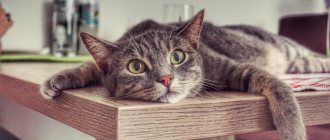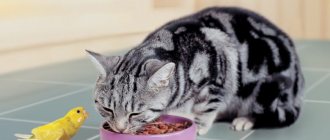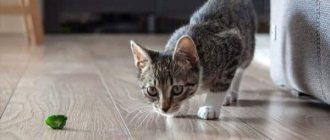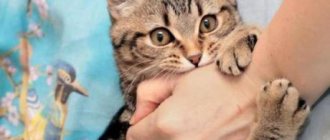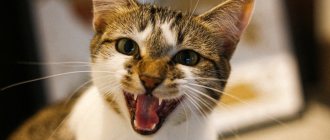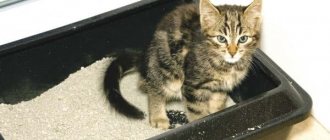Contrary to popular belief, an animal such as a cat is not only possible, but even necessary to educate. Especially if the pet is misbehaving.
First, make sure your cat is absolutely healthy. It is likely that your pet simply wants to get your attention because he has health problems or something is bothering him. After all, he doesn’t know how to convey to you the necessary information in any other way. So, if your animal is healthy, then you need to look for other reasons.
Why is a cat interested in climbing on the table?
The first reason is obvious - the cat climbs onto the table to get food from there. Perhaps he is fed up with his food and wants to find something tasty, or he is not full. We must not forget that cats are predators, which means they climb onto the table for prey. The owner’s task is to show that this cannot be done. Sometimes cats with a superbly developed sense of smell are attracted to the smell of food, especially if meat is being cooked.
A cat is not always attracted to food left on the table. Often this subject is of interest to him as:
- unexplored corner If there is something interesting on the table, it will certainly attract the four-legged naughty one. Cats are very curious creatures and are ready to explore everything in the house. If you leave something on the table after meals, then prepare for a visit from your pet.
- corner for sleeping Surprisingly, cats will happily sleep where there is a smell of food. This aroma has a calming effect.
- places to watch One of cats' favorite pastimes is to climb high and watch. The table works well as an observation post.
- warm place If the house or apartment is poorly heated, then the cat will want to find a warm corner. Warm air rises, and the pet will prefer to bask where it is higher. A kitchen table will do just as well as a cabinet.
Once you find out the reasons for your cat’s unacceptable behavior, begin to fight the bad habit.
Doesn't use the tray
If a cat begins to relieve its natural needs in various places not intended for this, then there may be a number of reasons for this.
- The first reason is that the tray the cat uses is not washed. Cats are animals that are famous for their cleanliness. There are even neat and tidy people who would never use an already dirty tray a second time. In this case, the problem is quite simple to solve. Just clean your cat's litter box often and use litter that eliminates odors. Do not use detergents with a strong smell to wash the tray. For example, such as bleach. Strong and pungent odors in the cat's litter box can cause the animal to have a persistent aversion to the potty. If you are forced to leave your pet alone for 2-3 days, give him another tray. So to speak, in reserve.
- The second reason is that the cat is not satisfied with the new litter. Cats by nature are very conservative animals. And if you are determined to transfer your pet to another filler, then it is better to do it gradually. Each time you fill your cat's litter box, mix in a handful of new litter with the old litter. And each time increase the dose of the new filler.
- The third reason why a cat ignores its toilet may be due to the fact that strangers have appeared on the cat's territory. For example, strangers entered the apartment, or a baby was born in the family where the cat lives. In this case, the animal decides that the threat of losing its territory looms over it and, like many animals in the wild, begins to place its marks.
Or maybe your pet has simply become an adult, sexually mature animal. In this case, the only solution may be castration. It should be done at the age of 10 months. At a later age, castration does not make sense, since the cat will already get used to leaving its marks. And then all you have to do is actually prove who’s boss in the house. Moreover, this will have to be done quite seriously, but of course without assault.
Yelling at an animal is completely useless. But to clearly explain to the cat who is boss here, grab him by the scruff of the neck and hiss in his face. After this, slap him in the face sharply, but not too hard, several times. At the same time, continue to hiss while looking the cat in the eyes. Thus, in cat language, you explain to the cat who is in charge in this territory. If after such a “conversation” the animal runs away to another room, you can celebrate your victory - this territory is yours!
In addition, you will need to drown out the cat's odors with your own. But don't be afraid of anything you might think. To do this, you need to thoroughly wash all the places where the cat left its marks with a strong-smelling detergent and then spray it with your perfume, cologne or deodorant. Such procedures may have to be repeated several more times, since your pet will probably try again to regain its dominance.
Feeding rules for owners
The first question for the owner is: is the cat eating enough? You may be mistaken in thinking that you are feeding your pet well. If you notice that your pet is stealing food from the table, make sure that you provide it with adequate nutrition.
When weaning your animal from climbing onto the table, follow a few “food” rules:
- before you sit down at the table, first feed your pet well;
- Offer a cat begging for food something unappetizing, for example, highly peppered meat. He must understand that your food is not tasty;
- Train your animal to wait quietly while you prepare dinner. Stop attempts at persistent begging. If you give in, the cat will decide to climb onto the table.
By weaning a cat from stealing food, it can show character and begin to starve. Your task is not to give in. Soon the pet will realize that it is better to eat what is in its bowl.
Cats steal food even when they are full - they are driven by curiosity or the instinct of a hunter. This behavior requires correction.
The cat is constantly begging for food
Quite often cats and kittens sin by begging. Even if there is a lot of food in their bowl. And almost every time you approach the refrigerator, you catch the hungry look of cat’s eyes full of reproach and reproach. Often you yourself are to blame for this. Having succumbed to such a pitiful look at least once, the cat’s owner forever becomes a hostage to the beggar.
Ways to combat begging
- Train your willpower. Having realized that they are going to influence you with a plaintive “meow” and an imitation of a hungry look, simply close the refrigerator and at least make an attempt to ignore the sufferer.
- Feed the animal from the common table as little as possible, even if your pet goes on strike and does not eat from its bowl. After a few days, the animal will probably break its voluntary hunger strike and will eat only from its feeder.
- You should not provoke your cat to steal. When leaving home, do not leave anything edible on the table and securely close all refrigerators and food cabinets.
How to make a table uninteresting for a cat
If the cat eats enough and still steals food by climbing on the table out of curiosity, then start with gentle methods. Try to make him lose interest in the table. Firstly, after eating, food must be removed so that nothing remains on the surface that attracts the animal. If there is no research item left, the cat may lose interest in the table.
If the table is empty almost all the time, but the cat still jumps there, it means that it is not food that attracts him. Animals love to watch what is happening from above. In this case, set up a tree house for your pet. A tall scratching post, a climbing tree, or a shelf against the wall will do.
Perhaps the cat found shelter on the table from small children or from the dog? Make sure you have a quiet and secluded area for him. The same applies to the desire to create a warm, cozy place to sleep. This is especially true in winter. Set up a cat bed near the radiator. You can rearrange the chair. And if the table is located by the window and serves as an observation point, then rearrange the kitchen.
Spreads claws
Absolutely all cats sharpen their claws - this is required by their hunting instincts. After all, in the apartment on the path of a domestic predator at any moment there may be tasty prey or a dangerous rival. This means that the beast must always be fully armed! Therefore, you will not be able to convince your pet. And you should only worry if the cat uses furniture or door frames instead of its scratching post.
Another reason may be that your cat is not yet a fully grown animal. In childhood, cats often have attacks of uncontrollable rabies. And then the animal eats everything that gets in its way. In this case, you should not scold your pet. Just unhook it from the surface that the animal has chosen as a scratching post and calmly, but clearly and firmly say “no!” 3-4 times.
Then take his front paws with his claws extended and repeat the scratching motion on the scratching post several times. After this, be sure to reward your pet with a kind word and a favorite treat.
As a radical remedy, the cat’s claws can be cut off. But this will solve the problem only for a while. After the claws grow back, the animal will again take up its work.
There are also special covers for claws. But in order to put them on you will have to tinker quite a bit. In addition, your pet will constantly try to remove them. In any case, only the owner can decide whether the safety of his furniture is worth such efforts. If your cat begins to struggle and scratch when he is picked up or simply petted, then it is quite possible that he simply cannot stand being touched too often.
Also, cats and cats most often do not like it when they are caressed against the grain or touched on the stomach. In cats, the abdominal area is the most vulnerable place and only the closest people are allowed to it. Those that the animal absolutely trusts.
Quite often, cat owners complain that their pets have developed a habit of ambushing children and adults. Most likely, the cat is not satisfied with its place on the hierarchical ladder in its “pack”. This can happen if a small child appears in the house, or children and other animals begin to mock her. Such antics of an animal can be quite dangerous for all family members and are quite difficult to stop.
To correct the situation, owners need to try to regain the trust of their pet. To do this, you just need to give your cat more time, take better care of it and play with the animal more often. In addition, you need to make it clear to children that animals cannot be teased or offended. And for a while, try not to leave your pet alone with children. If the measures taken still do not affect the situation in any way, the animal will apparently have to be given to other people.
The habit of occupying all horizontal surfaces is inherent in many cats. Cats and cats simply love to sleep in specially equipped cat houses and ordinary cardboard boxes. But, looking for a warmer place, representatives of the feline family go to sleep not only in special places designated for them, but also on any surfaces where it is at least a little warmer than in the rest of the apartment. For example, on a radiator, a windowsill heated by the sun, or even in the owner’s bed. Or directly directly on the sleeping owner. How to deal with this?
Many people, of course, like to lie in bed with their pet, but, of course, not everyone. And if your cat still bothers you in bed, just show him his place. If you constantly and persistently chase the cat out of bed, it will eventually understand that the place of the “leader of the pack” cannot be taken and will move to sleep in another shelter.
Bad habits of cats - how to get rid of them?
Cats are such willful and independent animals that rarely do any of their owners boast of impeccable behavior of their pet. Loving owners are ready to turn a blind eye to one-time pranks and pranks, but when this begins to happen regularly, we are talking about bad habits, many of which poison the lives of cat owners. To ensure that the animal in the house does not become a burden, the owner needs to find a compromise between his own peace of mind and the natural behavior of the animal. A well-mannered cat must also adapt to living together under the same roof with a person, so as not to be a constant source of trouble and irritation for the owner. Definitely, the best way to combat bad habits is to prevent them and raise the kitten, starting from a very young age. But, even if the habit has already taken root, there is still a chance to correct it if you approach it with patience and love, and try to understand the reasons that caused it.
In this article we will look at the main elements of cat behavior that most often cause dissatisfaction among owners, as well as the main ways to correct them.
The cat bites or scratches.
In the wild, biting and scratching is an absolutely natural behavior of predators, which includes our domestic cat, in this way they protect themselves from enemies and catch prey. You won't be able to completely stop your cat from claws or biting, but you can try to minimize its aggression. In most cases, the blame for the scratched legs of the owners lies entirely with the owners of the animal themselves, who initially could not explain the word “impossible” to the little kitten. It happens that the cause of an animal’s aggressive behavior is fear or illness. What to do? If we are not talking about an old, sick animal, then you should try to pick up the cat more often and play with it. Try to play with your favorite toys, do not allow the cat to even playfully bite or scratch your legs and arms. Never hit a cat - this will not help cope with aggression, but, on the contrary, will only embitter it. Even if the cat has confused your bare leg with a tree and is trying its best to quickly climb higher, do not hit it (sometimes animals perceive this as an element of the game), but rather splash water in the face. Usually two or three such wet lessons are enough to permanently discourage the cat from confusing your limbs with trees. Try to build a relationship with your cat based on respect - the animal also has the right to personal space. Do not forcefully hold a cat in your arms if it breaks free and rejects your caresses. Cats, like people, are not always in a good mood; sometimes they want to be alone .
The cat, sitting on her lap and purring with pleasure, suddenly begins to scratch and bite.
This behavior is familiar to many cat owners. The cat, showing all the signs of its complacency, sits quietly in its arms and enjoys communicating with its owner, who strokes it. Suddenly, for no apparent reason, the animal suddenly turns around and bites your hands. One of the explanations for this behavior is often found in the literature - a cat may at the same time enjoy the stroking of its owner, but at the same time, at the genetic level, the centuries-old experience of wild ancestors speaks of a possible danger. The cat tolerates the owner's touch to the last, but when it becomes, in her opinion, too strong, she tries to abruptly interrupt the contact and relieve stress using methods typical of cats - she tries to run away, begins to nervously lick herself, and may bite or scratch the owner. Such communication does not bring pleasure to either the cat or its owner. If your cat exhibits this behavior, do not pick her up until she asks for affection and climbs into your lap. If, while stroking the cat, you notice increasing tension in the animal, stop stroking it and, without removing your hands from your knees, carefully stand up. The cat will be forced to jump off without your help, so the conflict will exhaust itself before it even begins.
The cat does not want to use its toilet and defecates in the wrong places.
This is one of the most common reasons why many cats end up with relatives in the village, in a shelter, or simply on the street. In general, cats are very clean animals, and in most cases there are no problems with toilet training. If a small kitten makes piles in the corners and puddles, you need to act as quickly as possible, since in childhood it is much easier to influence the formation of cleanliness skills. At your nearest pet store you need to buy a convenient tray and filler for it. Now the industry produces different types of cat litter - wood, bentonite-based, and in the form of silica gel. They not only absorb moisture well, but also almost completely neutralize unpleasant odors; with such fillers, the cat's litter box will always be dry and clean. The cat potty should be in a quiet, secluded place so that no one interferes with the cat doing its “business”. If a previously clean cat suddenly begins to go to the toilet past the tray, or its posture changes when urinating or defecating, then this may indicate health problems, in which case it should be taken to the veterinarian for examination. Also, problems with toilet space in cats can arise under stress (the appearance of new furniture, renovations in the apartment, moving, the appearance of a new animal, the departure of the owners), or when the animal wants to attract attention to itself, in each case the reason for the appearance of this bad habit should be searched individually.
The cat throws litter from the tray
The habit of obsessively digging in the litter box before or after urinating or defecating is normal natural behavior for cats. In nature, the wild relatives of our domestic cats do exactly the same. Mountains of filler, raked out of the tray each time, deliver
a certain inconvenience for the owners. Correcting this behavior is quite easy, you just need to buy a tray with high curved edges or a closed toilet (toilet-house), in which the cat can dig as much as it likes without scattering litter around and without irritating the owners.
Animal marks territory
In the wild, this behavior is normal for them. But even an absolutely domestic cat, upon reaching puberty, can begin to mark its territory in the apartment with urine with a killer smell. There are many reasons why cats start marking - stress, the appearance of new animals, and even fear of someone in the family. The more intimidated and embittered the cat is, the more he will try to assert himself by marking his territory. But it happens that even in completely prosperous families with ideal conditions for keeping a cat, he begins to play dirty tricks. In this way, the self-confident apartment owner strives to show all the neighborhood cats how good he is and to lure potential brides to his place. Advice that in order to wean a cat from marking in his favorite place, you need to put a bowl of his food there - in most cases, they turn out to be ineffective; punishments are also not appropriate here. The only way out for desperate owners is castration. Castration not only helps to cope with this problem, but also generally has a positive effect on the cat’s character - aggressiveness decreases, the desire to wander disappears.
The cat begs or steals food from the table
In the vast majority of cases, such bad habits are reinforced with the help of the owners themselves. The cat will sit hunched over its bowl of food and look painfully into your eyes. Well, wouldn’t you give an incredibly hungry creature a tiny piece of your chop or cutlet? As soon as your heart clenches with pity and the cat receives the hard-won food from your table, know that the first step towards annoying begging and petty theft from the table and stove has been taken. Cats very quickly understand that they need to stay close to the kitchen and refrigerator. And even if, skillfully manipulating the owners, it is not possible to beg for something tasty, then the plaintive meowing and melancholy in the eyes can very easily be replaced by the dexterity of their paws and the impudence with which cats inspect the kitchen tables in the absence of their owners. Bad habits, reinforced by food irritants, form very quickly and are very difficult to eradicate. Therefore, do not give in to your cat’s pleas to give her a piece from the table; it is advisable to feed the animal before you start eating. The fact that food from our table has a very negative effect on a cat’s health will also help to gain determination and try to completely eradicate food theft and begging. Try not to provoke the animal - do not leave foods that are attractive to it on the table.
The cat walks in inappropriate places (furniture, kitchen table, sink, window sill)
The passion for conquering heights is, one might say, in the blood of cats; many simply adore viewing their surroundings from a height. That's why cats often jump on window sills, kitchen tables, and sinks. Since cat paws are not always perfectly clean, it is better to immediately wean your cat off such a bad habit. First of all, determine for yourself those places where the cat will be strictly forbidden to jump: the kitchen table, sink, bookshelf, and so on. If your cat tries to jump onto a forbidden place, strictly say “No!” and remove the animal. It will be easier if for a while the prohibited surfaces are completely forced by something so that it is not possible to jump on them. You can use the proven “old-fashioned” method - place a tray with metal dishes or cans on the edge of the kitchen table or sink, which will fall with a crash as soon as the cat tries to jump. Usually, after a couple of such attempts, the cat loses the desire to jump on what it considers dangerous furniture for a long time.
“Buries” his bowl after eating
This is also an echo of the predator instinct, when after a meal the animal should bury the leftover food so that its smell does not attract other predators. To stop this behavior, simply remove the bowl immediately after eating.
The cat only drinks water from the tap
Very often, cats categorically refuse to drink water from a bowl and wait until the tap in the bathroom or kitchen is turned on to drink running water.
If, when choosing this method of watering, the cat eats dry food, then it is likely to develop urolithiasis. You can offer your cat a special drinking fountain in which water constantly circulates. Another way to attract your cat's attention to the water bowl is to place it in an unusual place, such as on a windowsill in another room. .
The cat chews wires, Christmas tree rain, and other objects
This bad habit very often ends in the death of the animal, since due to the anatomical structure of the papillae on the tongue (they are curved and directed towards the pharynx), the cat has virtually no chance of spitting out the swallowed object. If your cat has repeatedly been noticed to have an increased interest in dangerous objects, try to exclude any possibility of eating them. Hide the wires under the baseboards or spray them with special bitter products (Anti-gryzin), do not decorate the Christmas tree, try to put potentially dangerous objects (coils, buttons, small toys) out of reach of the cat.
The cat gnaws indoor flowers
Many cat owners also find themselves the owners of chewed and tormented indoor flowers. Cats are ready to chew almost daily
their favorite houseplant. But there is always a danger of poisoning, since many of our indoor flowers are poisonous to cats. Therefore, try to keep your flowers out of the animal's reach. You can invite cats to visit their own greenhouse - wheat or oats sprouted in a bowl. Most cats like the taste of sprouted fresh grass, and, having constant access to greenery, they stop nibbling the unfortunate plants.
The cat meows in the middle of the night or wakes you up in the morning
This problem most often arises with unconscious encouragement on the part of the owner, when they begin to caress a cat that meows at night so that it calms down, and they rush to give food to the cat that is awakened early in the morning so that it lags behind. The cat very quickly begins to understand that with its meowing and persistence it can achieve anything it wants. To avoid being in the same apartment with a constantly screaming cat, you should teach it good manners from an early age. If an animal wakes you up in the middle of the night with its violent behavior or meowing, spray it in the face a couple of times with water from a spray bottle, this will help the cat “cool off the ardor” a little. Never feed your cat in the morning as soon as you get up. It is better to give food before leaving for work, in this case in the morning you will be spared from the intrusiveness of the cat demanding food, and it will be much more fun for her to while away the time alone near a bowl of food.
The cat claws furniture and wallpaper
This is the main reason why most people do not want to have cats at home. But, if you approach this problem wisely and show patience, then the destructive energy of cats directed at furniture, curtains and wallpaper can be transferred into a direction that is safe for the environment. It is not possible to explain to a cat that its claws cannot be sharpened at all; this is inherent at the genetic level. When a cat claws at your new leather sofa or expensive wallpaper
after repairs, she does this not out of harm or desire to “annoy” the owners, but only because this is part of the program for caring for her claws and marking the territory. A cat's claws are designed in such a way that a horny sheath grows over the nail, which the cat periodically removes by clinging to suitable surfaces. Install a convenient scratching post next to the furniture designated for tormenting by the cat . Surely the animal will become interested and, having tried it, will switch from the furniture to it. You can try covering the places chosen by the cat for claw care with double-sided tape. The cat will lose interest in furniture to which its paws stick for a long time. You can also go the already proven route and give the cat a “surprise” in the form of rattling and noisy objects that will fall on her head as soon as she touches the furniture.
Recently, a service offered by many veterinary clinics – soft paw surgery or onychectomy – has become increasingly popular. Despite the mild name, this is an operation that makes a cat disabled. Under general anesthesia, the cat's claw phalanges are amputated on the front paws (and sometimes on the hind paws too). Owners are often offered to perform such an operation along with castration, so as not to be given anesthesia twice. Advertising for veterinary clinics promises that after 7-10 days the stitches can be removed and the cat will continue to live a happy, full life, but will no longer be able to damage the owner’s furniture. But few people warn animal owners about the possible serious consequences of this operation. In cats, when walking, the emphasis is not on the entire foot, but only on the toes, so removing the phalanx of the toe leads to shortening of the foot and a decrease in the area of support - the animal simply will not be able to move as before. Due to improper distribution of the load, the activity of the entire musculoskeletal system will be disrupted, and the cat will literally have to learn to walk again. The sense of balance will also be impaired; your cat will never be able to run and jump with its former agility. And if such a crippled animal accidentally ends up on the street, then it has practically no chance to survive - the cat will not be able to climb a tree from a pack of stray dogs or defend itself in a fight with the neighbor’s cat. In most cases, after such an operation, cats begin to feel very insecure and become fearful and aggressive.
In many large veterinary clinics, owners are told about the consequences of this operation, giving them the opportunity to stop in time and not deliberately injure the animal. It doesn’t occur to anyone to cut off the fingers of people so as not to constantly have to do manicures, or of children in order to eradicate the bad habit of biting their nails. But at the same time, there are many small private clinics that, for the sake of making a profit (and onychectomy costs from 3,000 rubles) are ready to hide the truth about possible complications after such an operation. If you are just going to solve the problem of your cat ruining furniture in this way, imagine, at least for a short time, that the nail phalanges on your hands and feet will be amputated. There are a lot of nerve endings at the ends of the fingers, even an accidental single cut with a knife causes severe pain. And here we are talking about all fingers at the same time. Owners who are getting a kitten and, in order to preserve expensive furniture, prepare in advance for such an operation, would like to wish them to think again about the correct choice of a cat as a pet. Maybe it's better to get aquarium fish? Or put a plush cat on an expensive sofa? It certainly won't ruin the furniture.
Conclusion
In conclusion, I would like to remind you that cats are very independent and independent animals. They very quickly develop certain
habits, and they really don’t like it when their usual routine life suddenly changes dramatically for some reason. Most often, this puts cats in a state of extreme stress, with all the ensuing consequences and errors in behavior. Bad behavior in a previously obedient cat cannot occur without cause; the owner needs to analyze all the events to determine what may have caused it. You shouldn’t humanize a cat’s actions and think that the animal is taking revenge on you, wants to destroy your property, make you angry or humiliate you in the presence of guests. The cat does not act out of spite; it simply behaves as an animal should in a given situation. In most cases, the above bad habits are elements of the natural behavior of the wild relatives of our domestic cat, and they are completely justified. At home, they help the cat cope with nervous tension that accumulates with a lack of physical activity and emotional diversity. The more tolerant and peaceful the owner is, the easier and faster the conflict situation between man and animal is resolved. Physical punishment simply does not apply to cats. If a person hits a cat, it means that he simply does not have enough knowledge about the specific behavior of this animal. In this case, it is better to seek help from a specialist - a veterinarian or animal psychologist.
Passion for earthworks
Some cats really like to dig into flower pots. At the same time, cats break or eat the plants and flowers themselves. This problem can also be dealt with. To limit access to the soil in a flower pot, cover the space around the flower with a piece of thick cardboard or thick paper. There should be a hole in the covering for the flower stem, and the covering itself should be sealed with double-sided tape.
The next time you try to dig up the ground, the cat will begin to stick its paw to the tape. Naturally, he will not like this and most likely the animal’s craving for land work will weaken significantly.
To consolidate a lasting effect, leave the flower pot in this state for several weeks. To prevent your cat from eating the plant itself, feed it sprouts of sprouted oats, wheat or other grains. When in nature, cats usually eat grass in order to more conveniently empty their stomachs of hairballs that get there during washing.
